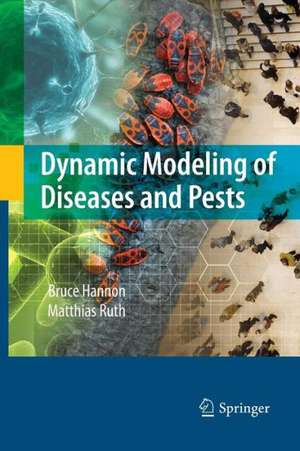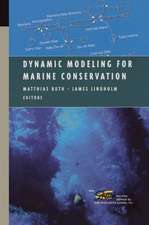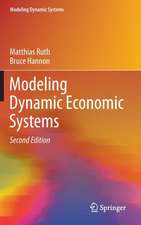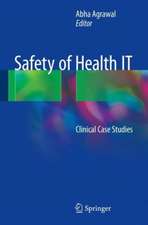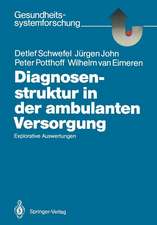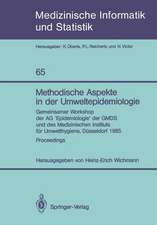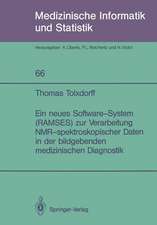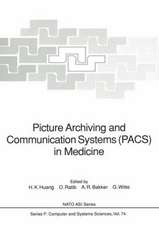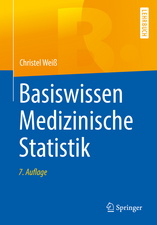Dynamic Modeling of Diseases and Pests
Autor Bruce Hannon, Matthias Ruthen Limba Engleză Paperback – 6 dec 2014
Models help us understand the nonlinear dynamics of real-world processes by using the computer to mimic the actual forces that result in a system’s behavior. The growing complexity of human social systems, from individual behavior to that of entire populations makes us increasingly vulnerable to diseases and pests. The ecology of the disease agents and the pests when considered in this social context only adds to the complexity. The feedbacks, lags in the effects of our preventive actions and the randomness in the environment make understanding of these vulnerabilities seem insurmountable. The amount and pace of modern travel provides virus and pest alike with the means to quickly find new hosts in untouched human populations and the ecosystems.
We thus have compelling reasons to understand the dynamics of these combined systems. This book begins with simple examples of human epidemics and then insect dynamics. Next comes the models of ever more complex models of disease carried by interaction of the two. An invasive species model is followed by insect-ecosystem interactions. The general models of chaos and catastrophe are linked to models of disease and pest. The final model is a spatial dynamic spread of disease among a wild animal population.
By using the STELLA programs (runtime versions and digital forms of all models are available with the book) we show how with a minimum of mathematical preparation and programming experience, these complex processes can be simulated and their emergent properties discovered. The programs run on both Macintosh and PC based machines.
| Toate formatele și edițiile | Preț | Express |
|---|---|---|
| Paperback (1) | 368.93 lei 6-8 săpt. | |
| Springer – 6 dec 2014 | 368.93 lei 6-8 săpt. | |
| Mixed media product (1) | 374.57 lei 6-8 săpt. | |
| Springer – 20 oct 2008 | 374.57 lei 6-8 săpt. |
Preț: 368.93 lei
Preț vechi: 388.34 lei
-5% Nou
Puncte Express: 553
Preț estimativ în valută:
70.60€ • 76.66$ • 59.31£
70.60€ • 76.66$ • 59.31£
Carte tipărită la comandă
Livrare economică 22 aprilie-06 mai
Preluare comenzi: 021 569.72.76
Specificații
ISBN-13: 9781489995032
ISBN-10: 148999503X
Pagini: 300
Ilustrații: VIII, 290 p.
Dimensiuni: 155 x 235 x 16 mm
Greutate: 0.42 kg
Ediția:2009
Editura: Springer
Colecția Springer
Locul publicării:New York, NY, United States
ISBN-10: 148999503X
Pagini: 300
Ilustrații: VIII, 290 p.
Dimensiuni: 155 x 235 x 16 mm
Greutate: 0.42 kg
Ediția:2009
Editura: Springer
Colecția Springer
Locul publicării:New York, NY, United States
Public țintă
ResearchCuprins
The Why and How of Dynamic Modeling.- Basic Epidemic Models.- Insect Dynamics.- Applications.- Malaria and Sickle Cell Anemia.- Encephalitis.- Chagas Disease.- Lyme Disease.- Chicken Pox and Shingles.- Toxoplasmosis.- The Zebra Mussel.- Biological Control of Pestilence.- Indirect Susceptible-Infected-Resistant Models of Arboviral Encephalitis Transmission.- Chaos and Pestilence.- Catastrophe and Pestilence.- Spatial Pestilence Dynamics.- Conclusions.- Conclusion.
Recenzii
From the reviews:
“The authors have written several textbooks that became classical in modeling dynamic systems, comprising various subjects and disciplines. Now they bring an exceptional work specially dedicated to diseases and pests. It is a book that can be very useful for beginners and intermediate or advanced modelers.” (Ruben La Rossa, Integrated Pest Management Bulletin, December, 2010)
“The authors have written several textbooks that became classical in modeling dynamic systems, comprising various subjects and disciplines. Now they bring an exceptional work specially dedicated to diseases and pests. It is a book that can be very useful for beginners and intermediate or advanced modelers.” (Ruben La Rossa, Integrated Pest Management Bulletin, December, 2010)
Notă biografică
Bruce Hannon is Jubilee professor of the College of Liberal Arts and Sciences and is associated with the departments of Geography, Ecology and Evolutionary Biology, Epidemiology and Preventive Medicine and Bioengineering and the National Center for Super Computing Applications and the Illinois Natural History Survey.
Matthias Ruth is Roy F. Weston Chair in Natural Economics, founding Director of the Center for Integrative Environmental Research at the Division of Research, Director of the Environmental Policy Program at the School of Public Policy, and founding Co-Director of the Engineering and Public Policy Program at the University of Maryland.
Matthias Ruth is Roy F. Weston Chair in Natural Economics, founding Director of the Center for Integrative Environmental Research at the Division of Research, Director of the Environmental Policy Program at the School of Public Policy, and founding Co-Director of the Engineering and Public Policy Program at the University of Maryland.
Textul de pe ultima copertă
Models help us understand the nonlinear dynamics of real-world processes by using the computer to mimic the actual forces that result in a system’s behavior. The growing complexity of human social systems, from individual behavior to that of entire populations makes us increasingly vulnerable to diseases and pests. The ecology of the disease agents and the pests when considered in this social context only adds to the complexity. The feedbacks, lags in the effects of our preventive actions and the randomness in the environment make understanding of these vulnerabilities seem insurmountable. The amount and pace of modern travel provides virus and pest alike with the means to quickly find new hosts in untouched human populations and the ecosystems.
We thus have compelling reasons to understand the dynamics of these combined systems. This book begins with simple examples of human epidemics and then insect dynamics. Next comes the models of ever more complex models of disease carried by interaction of the two. An invasive species model is followed by insect-ecosystem interactions. The general models of chaos and catastrophe are linked to models of disease and pest. The final model is a spatial dynamic spread of disease among a wild animal population.
By using the STELLA programs (runtime versions and digital forms of all models are available with the book) we show how with a minimum of mathematical preparation and programming experience, these complex processes can be simulated and their emergent properties discovered. The programs run on both Macintosh and PC based machines.
We thus have compelling reasons to understand the dynamics of these combined systems. This book begins with simple examples of human epidemics and then insect dynamics. Next comes the models of ever more complex models of disease carried by interaction of the two. An invasive species model is followed by insect-ecosystem interactions. The general models of chaos and catastrophe are linked to models of disease and pest. The final model is a spatial dynamic spread of disease among a wild animal population.
By using the STELLA programs (runtime versions and digital forms of all models are available with the book) we show how with a minimum of mathematical preparation and programming experience, these complex processes can be simulated and their emergent properties discovered. The programs run on both Macintosh and PC based machines.
Caracteristici
Introduces students to hands-on dynamic modeling in the context of disease, and challenges them to use their models and insights to explore interventions that may help restrain contagion The structure is based on the assumption that modeling is best learned by doing and by then critically evaluating the structure, performance and outcome of the model Contains generic models of epidemics and chapters on individual diseases, as well as other forms of “pests” for which humanity has devised intervention and control mechanisms, based on the use of STELLA software Begins with simple models, focusing on the motivation and act of modeling as much as on the specific features of what is modeled, and gradually proceeds to the development of fairly complicated models
